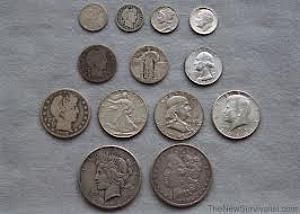

| Visitors Now: | |
| Total Visits: | |
| Total Stories: |

| Story Views | |
| Now: | |
| Last Hour: | |
| Last 24 Hours: | |
| Total: | |
The Ultimate Guide on How to Calculate the Silver Value of U.S. Silver Coins

What are common date U.S. silver coins? Common date U.S. coins refer to coins that were produced in high quantities. Because of the sheer number of them in circulation, they aren’t as popular amongst coin collectors or numismatists. Common-date U.S. silver coins are oftentimes referred to as junk silver coins, as they’re bought and sold primarily for their silver content, and are typically some of the more recent silver coins minted for general circulation. Whether you plan to sell them to silver coin buyers or pass them on to your children, here’s how to calculate the silver value of common-date U.S. coins:
Peruse your collection of common-date U.S. coins
Sort out your coins according to denomination and date. For instance, put all nickels dated between 1942 and 1945 together. Do the same for dimes, quarters and half dollars minted in 1964 and earlier, half dollars minted from 1965 – 1970, and U.S. dollar coins dated 1935 and earlier. All of these coins have various purities of silver content.
Take a closer look at your nickels dated between 1942 and 1945
Some of the nickels minted in 1942 and all of the nickels minted from 1943 – 1945 contained 56 percent copper, 35 percent silver, and 9 percent manganese. The shift was made from nickel to silver during World War II because of the high value of nickel during that time. Examine the reverse side of the coin to check if it’s a wartime silver nickel. If you find a large letter above Monticello’s image, the coin contains 35 percent silver. The letter or the mint mark on the coin tells you where the coin was made.
Group together your dimes, quarters, and half dollars dated 1964 and earlier
All of these coins are composed of 90 percent silver and 10 percent copper. After 1964, silver was no longer used to produce U.S. dimes and quarters.
Gather your half dollars dated from 1965 – 1970
While the production of dimes and quarters containing silver ceased after 1964, this wasn’t the case with half dollars. Half dollars that were produced from 1965 through 1970 contained 60 percent copper and 40 percent silver. However, after 1970, the use of silver was completely eliminated from U.S. half dollars.
Research the spot price of silver
This will let you know the current value of silver in the commodities market. In order to know the value of your common-date U.S. coins, multiply the percentage of silver in each coin by the spot price of silver. A quick and easy calculation is to multiply the spot price of silver (per troy ounce) by .7238. Multiply this figure by the denomination of your coin (e.g. .10, .25, .50) to arrive at the silver value of your coin.
While common-date U.S. silver coins may not be able to garner you as much cash as low mintage or rate coins, you’ll still be able to make money should you choose to sell them. Silver coin buyers engage in such transactions on a daily basis. First, peruse your collection of common-date U.S. coins, sort them according to their date and denomination, and lastly, research the spot price of silver to calculate the estimated silver value of your coins.
Submitted by Guest Blogger:
Atlanta Gold and Coin Buyers
2013-04-25 05:06:51
Source: http://finerarecoins.blogspot.com/2013/04/the-ultimate-guide-on-how-to-calculate.html
Source:


